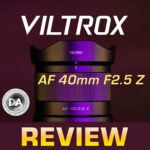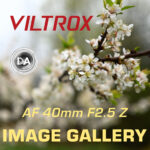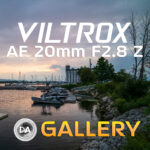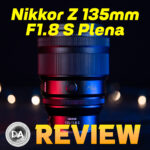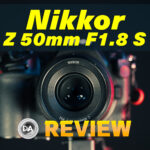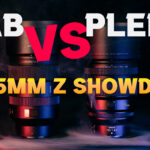
Viltrox AF 16mm F1.8 Z Mount Review
Both Canon and Nikon entered the mirrorless space with a moratorium on third party lenses, but Nikon has been more proactive about easing that stance, and now we are seeing a wave of excellent third party lenses come to Z-mount. I’m new to Z-mount myself, but I bought the excellent Nikon Z8 with a mind to being able to cover both Nikon Z-mount products as well as evaluate how third party lenses perform on Z-mount. I spent time with the excellent Viltrox AF 16mm F1.8 in May 2023 on Sony, and gave it high marks in my review there. I’m delighted to see this excellent lens come to Z-mount, as at the moment there really aren’t high quality wide angle primes wider than 20mm on the platform. The Viltrox 16Z will really fit a need here. This review will explore how well the Viltrox navigates the transfer to Z-mount. Find out more in my video review below…or just keep reading.
Follow Me @ YouTube | Patreon | Instagram | Facebook | DA Merchandise | Flickr | 500px | X
__________________________________________________________________________________________________
Thanks to Viltrox for sending me a review copy of this lens. As always, this is a completely independent review. All opinions and conclusions are my own. *The tests and most of the photos that I share as a part of my review cycle have been done with the 45MP Nikon Z8, which I reviewed here.
__________________________________________________________________________________________________
The 16mm was Viltrox’s first full frame lens to receive their new build, feature, and optical performance upgrades, which include weather sealing, the option to declick the aperture, two custom function buttons (more on that later), and, in a feature not seen since the Zeiss Batis series, an LCD screen on the lens that serves a variety of purposes. The response to this lens on E mount has been nothing short of enthusiastic, and I fully anticipate more of the same on Z-mount. Cameras like the Z8 are great landscape cameras while also being capable of capturing fast action; a 16mm lens with a fast maximum aperture can be handy for both.

But the Viltrox 16Z does not just impress on a feature level. This is a very wide angle lens (105.6° angle of view) that also happens to have a larger than average maximum aperture of F1.8 – that’s 1 1/3rd stop faster than the typical F2.8 zoom that covers this focal length. It manages to do this while retaining a moderate size (105mm in length) and weight (5653g) while delivering an exceptional optical performance.

This is a professional grade lens in both features and performance and will easily be perceived as being a very strong value. The MSRP as it comes to market is $549 USD (though if you buy it from the Viltrox store and use code DUSTINABBOTT you can get 8% any Viltrox product, including this lens), which makes this lens an absolute bargain. The closest competitor on Nikon at the moment is the Nikkor 20mm F1.8 S, a lens that costs nearly double that of the Viltrox while offering fewer features. That’s certainly going to make it interesting to perspective buyers!
Build and Handling
It is almost scary how quickly Viltrox has progressed as a lens maker. As noted in the intro, Viltrox is really leveling up in terms of lens design, and that shows up here in the design and features of the AF 16mm F1.8. Viltrox lenses have always felt a little more premium than their price points suggests, but this lens really checks all of the boxes of what we expect from a premium lens. In basically every way the Viltrox 16Z competes with the top S lenses from Nikkor.

The 16mm F1.8 is slightly larger in Z-mount than it was in E-mount due to the different flange difference and the larger mount diameter of Z-mount. The diameter is the same (85.2mm/3.35″), though the lens profile is slightly different to accommodate that large mount diameter. The lens is very slightly longer at 105mm/4.13″ in length. It weighs 565g or 19.4oz, about 15g more than the E-mount version. You can see those subtle differences in these comparison shots.


What is very welcome is that the front element is flat, not bulbous, so one can use common 77mm filters on the front threads. This isn’t a small lens, but the size and weight are reasonable for the focal length and aperture combination. The overall size and weight are actually very similar to the Nikkor 20mm F1.8 S, and, considering that the Viltrox has a wider focal length and additional features, that’s a bonus.

There are those who complain about the size and weight of the E-mount version, and that’s fair, though this is not a bad size and weight for this kind of lens. For me, personally, the performance of the lens makes the size and weight well worth it. It’s a very natural fit on a heftier body like my Z8.

The Viltrox 16Z has a fully featured approach to aperture. The aperture ring has markings (and clicks) at each one third stop between F1.8 and F22, then a gap with a harder stop between F22 and “A” (Automatic), which allows you to control aperture from the camera body instead. The lens also has a switch that allows you to declick the aperture. That switch is located on the right side of the lens underneath a stylish new Viltrox badge. When you turn the clicks off you can smoothly move through the whole aperture range without defined slots. This allows for smooth video aperture racking and has become an expected pro-grade feature on modern lenses.



On the left side of the lens we have an AF/MF switch, which is a feature that I always personally welcome as I think it is most the logical way to control that function.

Beneath that is a feature fairly unique to this – dual FN (function) buttons. The top one functions like the typical function button, performing whatever function you have that button programmed to in camera. The second button is going to be used more commonly for video functions, however, as when in manual focus mode it allows you to preset two focus positions and automatically switch between the two at the press of the button (A-B focus). This works in conjunction with the LCD screen on the top of the lens (more on that in a moment). You can preset the focus position by long pressing the FN 2 button, and then access the focus changes by short pressing it. The feel of the buttons in the Z-mount version are improved over what I found on the Sony version – the buttons feel more precise and responsive and less rubbery.

Now to that LCD screen. The LCD functions in many ways like those found on the Zeiss Batis lenses, though with some improvements. The screen itself is nice and bright, allowing for good visibility even in bright conditions. It solves the problem of a distance scale (something missing on most mirrorless lenses), as it gives you a large font telling you the precise focus distance along with a distance scale above that. The bottom part of the screen gives you a readout of the current aperture, which is more useful if you are electing to not use the manual aperture ring and are controlling aperture from within the camera. It also gives you some information related to the function buttons however, with the Fn icon lighting up when the first Function Button is depressed, and then the A function lights up when you are presetting focus distances. There is a small green arrow that shows the current focus distance, and then you can preset the two desired focus distances which will be marked with a small orange arrow over the top of the both of them. There’s actually a lot of useful information on the LCD screen once you get familiar with how it is all being displayed.

The chief complaint about the LCD screen for most people is that the distance information it displays isn’t always accurate.
The manual focus ring is made of metal with tight ribbing. It moves smoothly and with nice damping with over 360° of rotation here on Nikon. It does quite a good job of imitating true manual focus for a “focus-by-wire” lens, and I prefer Nikon’s manual focus process to that on Sony.

We also have weather sealing on this lens that starts with a unique maroon-colored gasket at the lens mount along with other seal points through the lens. I see 12 different sealing gaskets in this diagram.

That’s very important in a landscape lens, as often the best photos come when the weather is, well, unpredictable.

This is an internally focusing lens, so there is nothing that moves where dust might intrude. There’s also an HD-Nano multilayer coating on the front element to help with water and fingerprint resistance, making the front element easier to clean. As always, however, “moisture-proof” does not mean “water-proof”, so don’t go crazy!
Viltrox continues with a trend that other lens makers are now imitating by including a USB-C port in the lens mount that allows you to do firmware updates right to the lens. I’m a fan of this approach, as it eliminates the need for a separate dock or lens station for firmware updates, and I find the process a little more intuitive than even doing firmware updates through the camera. This allows Viltrox to future proof their lenses and continue to improve them through firmware.

But Viltrox never seems to rest on their laurels. I’ve frequently seen them add new features even when releasing the same lens on a new platform (as here). They’ve added a Bluetooth module to the Z-mount version of the lens, and through their new app for IOS or Android, you can also update firmware wirelessly. Right now the app function seems to be limited to just firmware updates, though the promise is that they will add more functionality to the app control in the future.



There is no image stabilization, though thanks to the IBIS (in body image stabilization) of my Z8, I didn’t really notice. The IBIS worked well to stabilize the lens and provide steady results for stills and video.
There are nine rounded aperture blades inside, and the aperture iris stays reasonably round as the lens is stopped down, though this is hard to test on a lens with a very wide angle of view and a fairly big minimum focus distance.

The look of the sunstars when the lens is stopped down is actually quite nice.

One lingering Viltrox weakness remains, and that is in minimum focus and maximum magnification performance. MFD is 27cm (10.6″) and the resulting magnification is only 0.10x, which looks like this.

On the plus side the up close performance is good even at F1.8 with good detail and contrast in the area of focus, though the plane of focus isn’t completely flat up close like that. You can still blur out backgrounds somewhat, though don’t expect them to “disappear”.

The materials in the barrel design are very nice, with everything made of metal and nicely executed…with one exception. The lens hood is petal shaped and made of lightweight plastic, and frankly feels a little cheap compared to the rest of the lens (somewhat like many Fuji lenses). Also included is a pouch to store the lens is, though it doesn’t offer much protection.

You do have to have to watch that hood, too, as if you knock it (like I did while taking it out of my bag here), it can rotate a bit and cause a mechanical vignette in the corners that will ruin your images…like this:

Beyond those few weaknesses, however, this is a very nicely executed package. The lens feels high quality in the hands, and it handles nicely as well. It’s a professional grade lens that looks very natural on my Z8 body.
Autofocus and Video
The Viltrox 16mm is equipped with a Lead Screw-type STM (stepping motor), which is the better of the two different STM designs. I prefer Linear over STM, but this is a well executed STM motor, delivering fast, silent, and accurate autofocus results. The focus motor is extremely quiet, and in my tests I found that autofocus speed was excellent both indoors and outdoors.

I did sometimes run into the issue autofocus was reluctant to grab a close foreground object, though that seemed to be a common occurrence with all three lenses I was testing on Nikon, so it may be more of an autofocus system issue than something specific to this lens.
Eye AF results were good with animal subjects, even if they were in the process of moving.

Probably most important for a lens like this was consistent results for landscape and interior related work, and I found that the autofocus system was flawless for things like that.

One of the key improvements on Nikon relative to Sony is that Nikon does not artificially limit the burst rate for third party lenses as Sony does. I was able to rattle off bursts at 30FPS, and got tracking throughout.



A timelapse of action at 30FPS looks pretty much like a video, and that’s one key advantage here on Nikon for owners of this lens.
I used the Sony version of the lens in a portrait setting, and focus worked quite well, though with one caveat: wide angle lenses don’t really work with Eye AF unless you are fairly close. It has nothing to do with this Viltrox lens, per se, but is just the reality of a very wide angle of view where the eye doesn’t occupy a large enough area of the frame to be detected. In fact, move out beyond 7 or 8 meters and a face isn’t even large enough. I wanted to see the Eye AF box more during my portrait session (I’m used to seeing it!), but the actual results were well focused.

Video AF was also good. My focus pulls were smooth and accurate, and I heard no audible focus sounds. Focus confidence was high on both ends of the focus pulls, and focus breathing is well controlled on this lens.
My “hand test” where I put my hand out to block my face and then remove it to allow focus snap back to the eye went well overall, with good confidence in the eye detection. Focus speed was a little slow for this test, so if you want reactive focus changes, it would help to turn the focus speed in camera up.
I found that the more cinematic tuning at default settings worked well for situations where I wanted focus to “glide” from one subject to another.
You can add these strong video AF performances to the video-specific features this lens already has. This is not a bad option at all for someone wanting a very wide angle lens to do video with. It also has relatively low distortion, making this a tempting option for someone who wants to shoot interiors or real estate photography/videography. Real world distortion, even without correction, is not bad at all.

I walked away impressed following my focus tests. I’m still in the process of becoming familiar with the Nikon AF system myself, but I saw enough in my tests to feel confident that Nikon shooters will be happy with what they get out of the AF of the Viltrox 16Z.
Image Quality Breakdown
We have a fairly complex optical formula of 15 elements in 12 groups, and that includes 7 exotic elements (either aspherical or ED low dispersion elements). The MTF chart shows extremely strong center performance, good mid-frame, and only a slight dip towards the corners. By F8 the results range from about 83% sharpness in the center to 77% in the extreme corners – a very, very flat (consistent) sharpness profile that is exceptionally good for a wide angle lens. I reviewed the E-mount version of the lens on a 61MP a7RV, so while the Z8 has a high resolution point of 45MP, this is actually an easier test for the lens.

I started reviewing Viltrox lenses right at the beginning, and at first I was less than impressed by the optical glass when it came to colors. I never felt colors were as natural as the better lenses, and as a result I felt like they quickly got garish when pushed at all. But Viltrox has switched to a higher end Hoya optical glass partnership in the past year, and the results show in lenses like this. At it’s best, the Viltrox 16mm F1.8 is capable of very nice color.

Another historical point of weakness for Viltrox lenses is that they often exhibited some noticeable LoCA (longitudinal chromatic aberrations), but again, the trend has been in the right direction. That trend continues here, with only the mildest amount of fringing visible even in demanding situations.

I’m also satisfied with the control of LaCA (lateral chromatic aberrations) that typically show up along the edges of the frame with high contrast transition points. Here we can see that even at F8 there is essentially a perfect transition from black to white near the edge of my test chart.

I also found no fringing in real world images along the edges of the frame – the transitions from branches or leaves to sky are clean here.

If we move on to vignette and distortion we find the biggest optical weaknesses, though they aren’t extreme. There is relatively little distortion though what is there isn’t very linear. My manual corrections did about as much harm as good, as correcting the bit of barrel distortion with a +2 produced a bit of pincushion distortion in the edges. For most real world images the amount of distortion is so mild that you are better off leaving it uncorrected. Vignette was a little heavier on Z mount, requiring a +91 to correct (over three stops in the corners).

The vignette is definitely heavy enough that you’ll essentially always want to correct it. There appears to be some measure of vignette correction in camera for JPEGs, but not always sufficient if shooting at wide apertures.
Not a perfect performance thus far, but nothing too severe. There’s obviously more vignette than what I would like, but the $3000 Zeiss Distagon 15mm F2.8 had as much or more. Vignette is a small price to pay for being able to retain a flat front element and the ability to use traditional filters.
We’ll move on to inspecting our test chart. This test has been done on a 45MP Nikon Z8 sensor. I use a high end tripod and two second camera delay to ensure vibration doesn’t affect images. Here’s a look at the test chart that we will examine at high magnification:

If we take a look at crops (at about 180%) at F1.8 from the center, mid-frame, and lower right corner, we find that center performance is fantastic, and the mid-frame and corners remain fairly strong.



Real world results are impressive even wide open, with great sharpness and detail:


That adds up to a very useful lens for night photography in the city or low light situations. You can trust on getting sharp images even at large apertures, which is (to me), kind of the point of having a large aperture in a wide angle lens. I typically will stop down even a sharp lens for landscape purposes because I want a deeper depth of field, but in low light situations I prefer staying with large apertures to be able to keep the ISO down and get cleaner images. I shot in the very early predawn light and could get very nice looking results.

A large aperture also gives you the opportunity to play with depth of field a bit. I focused as closely as I could here on a toy car I found on an island and got a bit of a miniature effect out of it.

Stopping down to F2 provides a very slight improvement to contrast and detail, but there’s a more appreciable improvement at F2.8. The corners are starting to look quite excellent.

I haven’t yet tested the Nikkon Z 20mm F1.8 S, but from the MTF chart comparisons it looks like the two lenses deliver a very similar performance. The Viltrox 16Z is delivering crisp results all across the frame at F2.8.

By traditional landscape apertures the lens is razor sharp across the frame. The beauty of a lens like this is its ability have a lot in focus at once.



This is the kind of lens that delights you both on a broad scale and then as you dive into the details. It handles higher resolution bodies with ease.

Lenses like this work well with higher resolution cameras because of the ability to deeply crop and get more framing options out of an image. These days you can almost always crop in more, but you can’t always step back further to get more in the frame.

Diffraction will start to soften the image by F11, but that effect will be much more noticeable at F16 or F22 (minimum aperture here).

A 16mm lens is hardly going to be a bokeh machine, but the quality of the bokeh isn’t bad. F1.8 is quite a wide maximum aperture for this focal length, though the fairly large minimum focus distance will limit just how strongly you can blur the background.

The shot above is a little future away, but here’s absolute minimum focus and as much blur as is possible for this shot.

There is some outlining to the specular highlights (bokeh balls), but the overall feel of the image is relatively soft.
I did enjoy getting low with this lens and capturing a “little world”.

A wide angle lens with a large maximum aperture is always going to be an interesting option for shooting the night sky, and the Viltrox AF 16Z is a better than average star catcher. Some clouds starting coming in on the night that was predicted to be clear, but I was still able to evaluate the coma performance on this Z-mount version of the lens. Star points are nice and crisp in the center of the frame, and the final crop was the worst I could find near the corner where there is a bit of coma smear. My crop is near 200%, however, so you won’t see it even this badly under normal conditions.



The bright F1.8 aperture and wide angle of view will make this a very tempting option for doing astro or nighttime city work, and the low coma will certainly help.

Flare resistance is fairly good but not perfect. At wide apertures (the ones without a defined sunburst effect), there is little flare artifacts. I saw a bit more ghosting at smaller apertures (like F11), though I do like the sunburst effect from the 9 aperture blades.



Sometimes if the sun is right out of the frame you can get a few light streaks, but nothing too destructive.

Overall, I think the flare resistance is quite good for a wide angle lens. I’ve seen better, but most wide angle lenses are worse than this, particularly when you consider how wide the maximum aperture is. This is a lens that can produce a lot of great looking images…even if the sun is in the frame.

The bang for the buck ratio for this lens is pretty fantastic. It delivers great optical results at a truly reasonable price…and also fills a focal length gap here on Nikon Z-mount. You can check out more photos by visiting the image gallery here.
Conclusion
One of my main reasons for adding a Nikon body to my kit was to be able to cover Z mount versions of lenses like this. I love what Viltrox is doing right now, and their roadmap over the next few years looks particularly exciting as they tackle both high end lenses (upcoming LAB series) along with very competitive budget options (like the AF 40mm F2.5 Z-mount lens I’m reviewing alongside this one.) I’ve only had a few weeks with my Z8, but having the Viltrox AF 16mm F1.8 Z on hand to explore it with has been a lot of fun.

Viltrox clearly engineered first for Sony E-mount (that version has been out for a year), but it feels like this lens works as well on Z-mount as it did on Sony. I actually prefer the Nikon approach to things like manual focus, and it is worth noting that third party lenses don’t have the burst rate limitations on Nikon that Sony imposes. You could use this lens more easily for action and fast bursts.
The Z8 is also a nice landscape camera, and this is a nice landscape lens.

As I said in my E-mount review, it would actually be difficult for me to suggest an alternative to this lens that could compete with its performance and features at this price. The Viltrox AF 16mm F1.8 Z is going to be a disruptor on whatever platform it comes to because it checks so many boxes and at such a compelling price point. I’ve had just as much fun with this lens on Nikon as I did on Sony, and I look forward to making beautiful images with it in the future. If you want a high performing wide angle prime for your Z-mount body…look no further. And if you buy from Viltrox and use the code DUSTINABBOTT, you can drop the price to right over $500 USD. That leaves money in your pocket…which if you’re like me, you’ll probably end up spending on another lens anyway!
Pros:
- High level build quality
- Very feature rich
- Weather sealed
- Unique LCD screen useful
- Retains traditional filters
- STM focus motor quick and accurate
- Can keep up with action even at high speed bursts
- Minimal focus breathing
- Excellent sharpness at F1.8
- Covers a focal length not well covered by Nikkor lenses
- Excellent control of aberrations
- Very little distortion
- Good color
- Good coma performance
- USB port for firmware updates
- Bluetooth for app connection
- Amazing price to performance ratio
Cons:
- Vignette a little heavy
- Lens hood can be easily rotated and will cause vignette
- Low maximum magnification
_________________________________________________________________________
GEAR USED:
Purchase the Viltrox AF 16mm F1.8 @ Viltrox (use code DUSTINABBOTT for 8% off) | B&H | Nuzira | Adorama | Amazon | Amazon Canada | Amazon UK | Amazon Germany
_______________________________________________________________
Purchase the Nikon Z8 @ B&H Photo | Adorama | Amazon | Camera Canada | Amazon Canada | Amazon UK | Amazon Germany
_________________________________________________________________
Want to support this channel? Use these affiliate links to shop at: B&H Photo | Amazon | Adorama | Camera Canada | Amazon Canada | Amazon UK | Ebay | Make a donation via Paypal
Buy DA Merchandise https://bit.ly/TWIMerch

Purchase the Nikon Z8 @ B&H Photo https://bhpho.to/3yaMuDB | Adorama https://howl.me/cmcvUHymQIt | Amazon https://amzn.to/3UQjfi0 | Camera Canada https://shrsl.com/4ipga | Amazon Canada https://amzn.to/3UtFSHL | Amazon UK https://amzn.to/4bsf1Tn | Amazon Germany https://amzn.to/4drP4oN
Keywords: Viltrox, Viltrox AF, Viltrox 16mm, Wide Angle, Full Frame, F1.8, f/1.8, STM, Viltrox AF 16mm F1.8, Viltrox 16mm Review, Viltrox AF 16mm F1.8 Review, LCD Screen, Nikon, Nikon Z8, Z, Z-mount, Z8, Review, mirrorless, Full Frame, Sports, Tracking, Dustin Abbott, Real World, Comparison, Handling, Focus, Portraits, Resolution, High ISO, Image Quality, Sample Images, Photography, 45MP, #letthelightin, #DA, #NIKON, #Z8, #NIKONZ8


